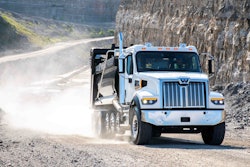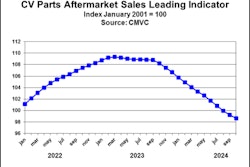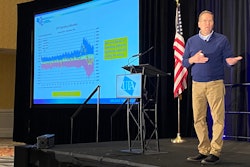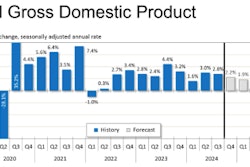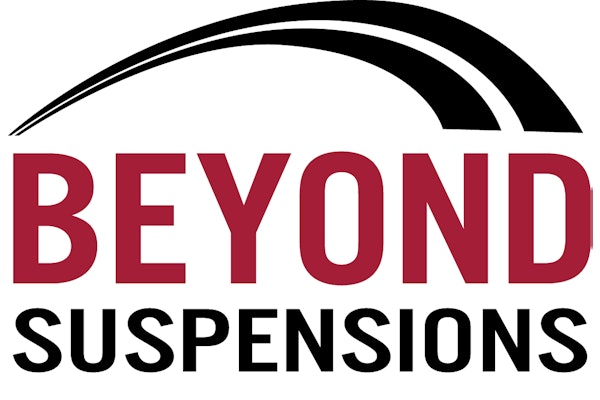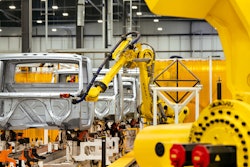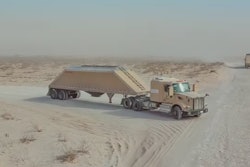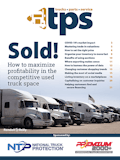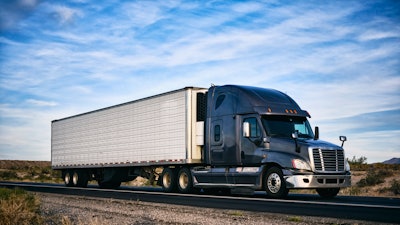
Disruption is the watchword as the trucking industry says goodbye to 2024 and moves into 2025. A new presidential administration, looming emissions regulations and record-high inventories will all factor in to how heavy-duty will do in the new year.
A panel of FTR analysts, including CEO Jonathan Starks; Chairman of the Board Eric Starks; Joseph Towers, senior analyst for rail; Dan Moyer, senior analyst, commercial vehicles; and Vice President of Trucking Avery Vise, talked about some of the catalysts for change in the market — or the lack thereof.
"We're kind of bouncing along the bottom," Vise says, talking about freight rates. And with slow growth in the goods transport sector, gross domestic product and spending all, the bouncing isn't all that surprising.
Where spending is growing, Vise says, is on things that don't take up room on a trailer, such as information processing equipment such as computers. Towers used industrial production as his metric, which is also flat.
"You could put a level on it and the bubble would be right in the middle," he says. "We really haven't seen any change."
In this case, Eric Starks says, that stability is a good thing. In his opinion, the Fed's interest rate cuts gave the U.S. economy the soft landing it was looking for, and consumer spending has held up.
"(2024) has been a little bit stronger than I anticipated," he says.
Labor markets also are holding steady at tighter levels, even with disruption in the labor market from rail and port strikes. A Gulf and East Coast port strike looms again in January; Towers says there's a high likelihood of another stoppage as negotiations deteriorate. In the coming months, that could shake confidence in the traditionally stable ports.
Much of the uncertainty in the forecast comes from the potential policies of a new Trump administration. President-elect Donald Trump takes office Jan. 20 and has promised a Day 1 tariff on goods from Mexico, Canada and China. He's also promised a crackdown on immigration.
"There is certainly big potential for disruption in the composition of this labor force," Jonathan Starks says. The most affected markets would be agriculture and construction, but that could spill into trucking. Construction is typically the primary competitor for trucking labor, and as immigration policies open up jobs and push wages up in construction, trucking could see some of it's workforce drawn off.
"Where I'm kind of thinking about things, in the first part of the year and the change in administration, if the administration did nothing, we'd continue along a healthy path," Eric Starks says.
However, tariffs, retaliatory tariffs and immigration policies could create a more unstable environment.
"From an economic standpoint, I'm definitely concerned," Eric Starks continues.
The panel says while this year has been flat, they've had some difficulty finding a catalyst for any kind of growth to eat into pent-up power unit inventories.
"I just don't see it having a lot of legs to take off," Eric Starks says, whether there are tariffs and immigration crackdowns or not.
"It just seems difficult to craft a plausible scenario that gets you to a lot more strength," Vise says.
Tariffs could push into the Class 8 and medium duty inventories, Moyers says. Any fleets looking to upgrade equipment may opt for units that are already built rather than trying to order a new unit that may be delayed from supply chain snarls or more expensive because of tariffs, or both.
But, "we still expect demand to be pretty weak next year," he warns.
The regulatory environment so far as emissions are concerned will likely remain unchanged, the panel agreed, and it remains to be seen what changes a Trump administration would make. That said, the looming EPA Phase 3 regulations, among others, will exert pressure on commercial vehicle sales.
"There's potential here for a huge impact," Moyers says, as any potential tariffs will hit as the industry prepares to transition to trucks that comply with the new regulations.
Around 40% of U.S. Class 8 units are built in Mexico, he says, and 25% of medium-duty trucks are built in Mexico or Canada. A 25% tariff on imports would almost certainly drive up the cost of trucks, trailers and parts. Retaliatory tariffs, particularly from Canada, would also have a pronounced affect. Moyers says around 65% of Canadian Class 8 units are built in the U.S.
Furthermore, millions have been invested in supply chains in North America. Tariffs would threaten those manufacturing links.
"It has the potential to really strain supply chains, which are really fragile post-COVID," Moyers says.
Much of the trade across borders also runs by truck, Vise says. He also doubts these tariffs would drive up domestic production. Eric Starks says nearshoring isn't a realistic goal at this point.
"We just can't ever produce some of this stuff," he says. "So all we're going to do is bring it in. And that creates the retaliatory situation that hurts the farmers more than anybody."

